Influencing and Decision Making: Analysis of Techniques and Processes
VerifiedAdded on 2021/04/17
|13
|3789
|78
Report
AI Summary
This report delves into the critical aspects of influencing and decision-making within organizations. It examines the importance of decision-making abilities, essential skills, and various methods, models, frameworks, and taxonomies employed in individual and organizational contexts. The report explores the significance of decision-making in achieving organizational objectives and goals, highlighting its strategic and complex nature. It discusses different decision-making methods, including Nominal Group Thinking, the Delphi method, and the Stepladder method. Furthermore, the report analyzes prominent decision-making models such as the rational/classic model, the administrative model, and the retrospective model. Finally, it presents a framework for effective decision-making, including identifying problems, gathering information, developing options, choosing the best option, and taking follow-up actions. The report emphasizes the continuous and dynamic nature of decision-making, highlighting its importance in modern management and organizational success. This report is a helpful resource for students on Desklib.
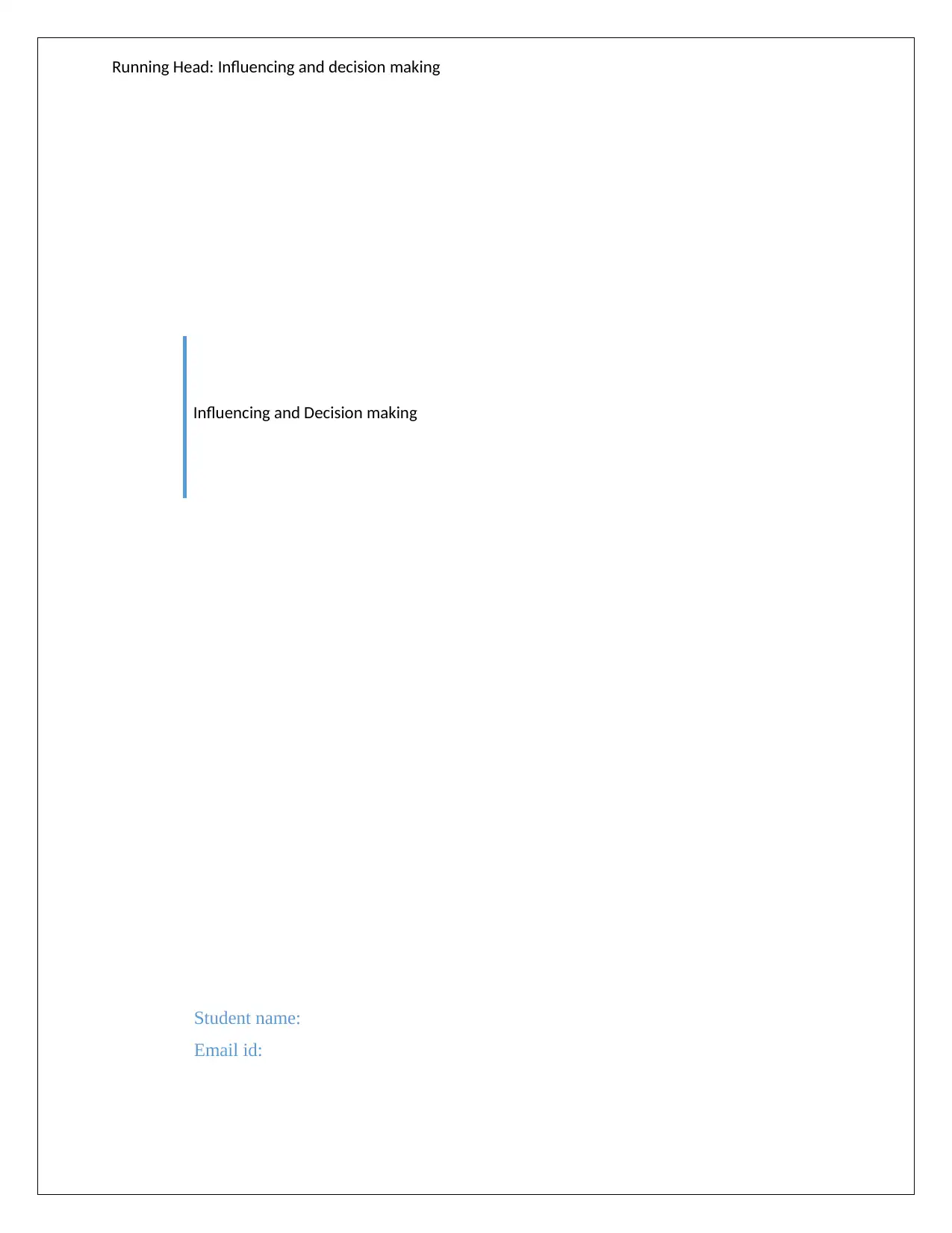
Running Head: Influencing and decision making
Influencing and Decision making
Student name:
Email id:
Influencing and Decision making
Student name:
Email id:
Paraphrase This Document
Need a fresh take? Get an instant paraphrase of this document with our AI Paraphraser
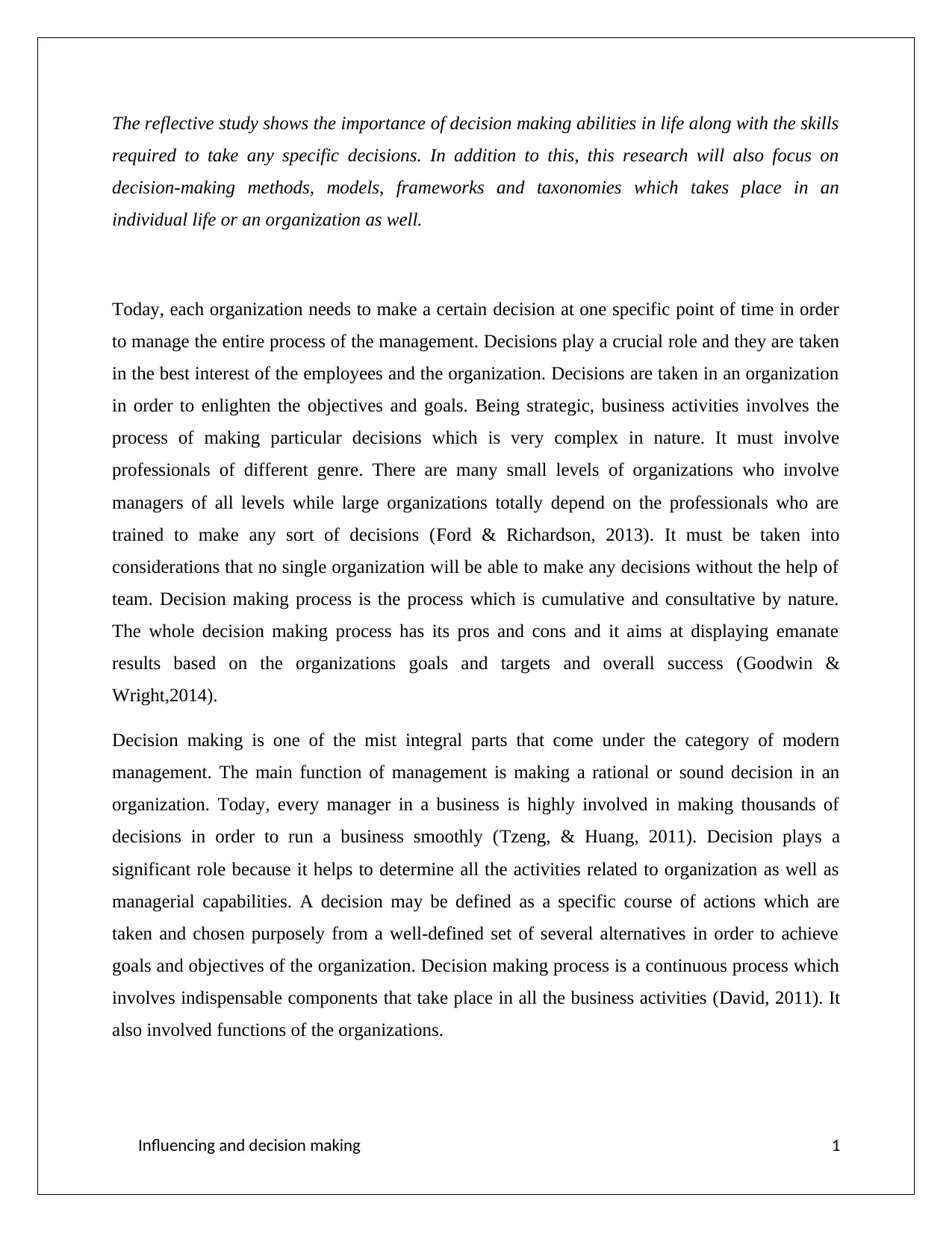
The reflective study shows the importance of decision making abilities in life along with the skills
required to take any specific decisions. In addition to this, this research will also focus on
decision-making methods, models, frameworks and taxonomies which takes place in an
individual life or an organization as well.
Today, each organization needs to make a certain decision at one specific point of time in order
to manage the entire process of the management. Decisions play a crucial role and they are taken
in the best interest of the employees and the organization. Decisions are taken in an organization
in order to enlighten the objectives and goals. Being strategic, business activities involves the
process of making particular decisions which is very complex in nature. It must involve
professionals of different genre. There are many small levels of organizations who involve
managers of all levels while large organizations totally depend on the professionals who are
trained to make any sort of decisions (Ford & Richardson, 2013). It must be taken into
considerations that no single organization will be able to make any decisions without the help of
team. Decision making process is the process which is cumulative and consultative by nature.
The whole decision making process has its pros and cons and it aims at displaying emanate
results based on the organizations goals and targets and overall success (Goodwin &
Wright,2014).
Decision making is one of the mist integral parts that come under the category of modern
management. The main function of management is making a rational or sound decision in an
organization. Today, every manager in a business is highly involved in making thousands of
decisions in order to run a business smoothly (Tzeng, & Huang, 2011). Decision plays a
significant role because it helps to determine all the activities related to organization as well as
managerial capabilities. A decision may be defined as a specific course of actions which are
taken and chosen purposely from a well-defined set of several alternatives in order to achieve
goals and objectives of the organization. Decision making process is a continuous process which
involves indispensable components that take place in all the business activities (David, 2011). It
also involved functions of the organizations.
Influencing and decision making 1
required to take any specific decisions. In addition to this, this research will also focus on
decision-making methods, models, frameworks and taxonomies which takes place in an
individual life or an organization as well.
Today, each organization needs to make a certain decision at one specific point of time in order
to manage the entire process of the management. Decisions play a crucial role and they are taken
in the best interest of the employees and the organization. Decisions are taken in an organization
in order to enlighten the objectives and goals. Being strategic, business activities involves the
process of making particular decisions which is very complex in nature. It must involve
professionals of different genre. There are many small levels of organizations who involve
managers of all levels while large organizations totally depend on the professionals who are
trained to make any sort of decisions (Ford & Richardson, 2013). It must be taken into
considerations that no single organization will be able to make any decisions without the help of
team. Decision making process is the process which is cumulative and consultative by nature.
The whole decision making process has its pros and cons and it aims at displaying emanate
results based on the organizations goals and targets and overall success (Goodwin &
Wright,2014).
Decision making is one of the mist integral parts that come under the category of modern
management. The main function of management is making a rational or sound decision in an
organization. Today, every manager in a business is highly involved in making thousands of
decisions in order to run a business smoothly (Tzeng, & Huang, 2011). Decision plays a
significant role because it helps to determine all the activities related to organization as well as
managerial capabilities. A decision may be defined as a specific course of actions which are
taken and chosen purposely from a well-defined set of several alternatives in order to achieve
goals and objectives of the organization. Decision making process is a continuous process which
involves indispensable components that take place in all the business activities (David, 2011). It
also involved functions of the organizations.
Influencing and decision making 1
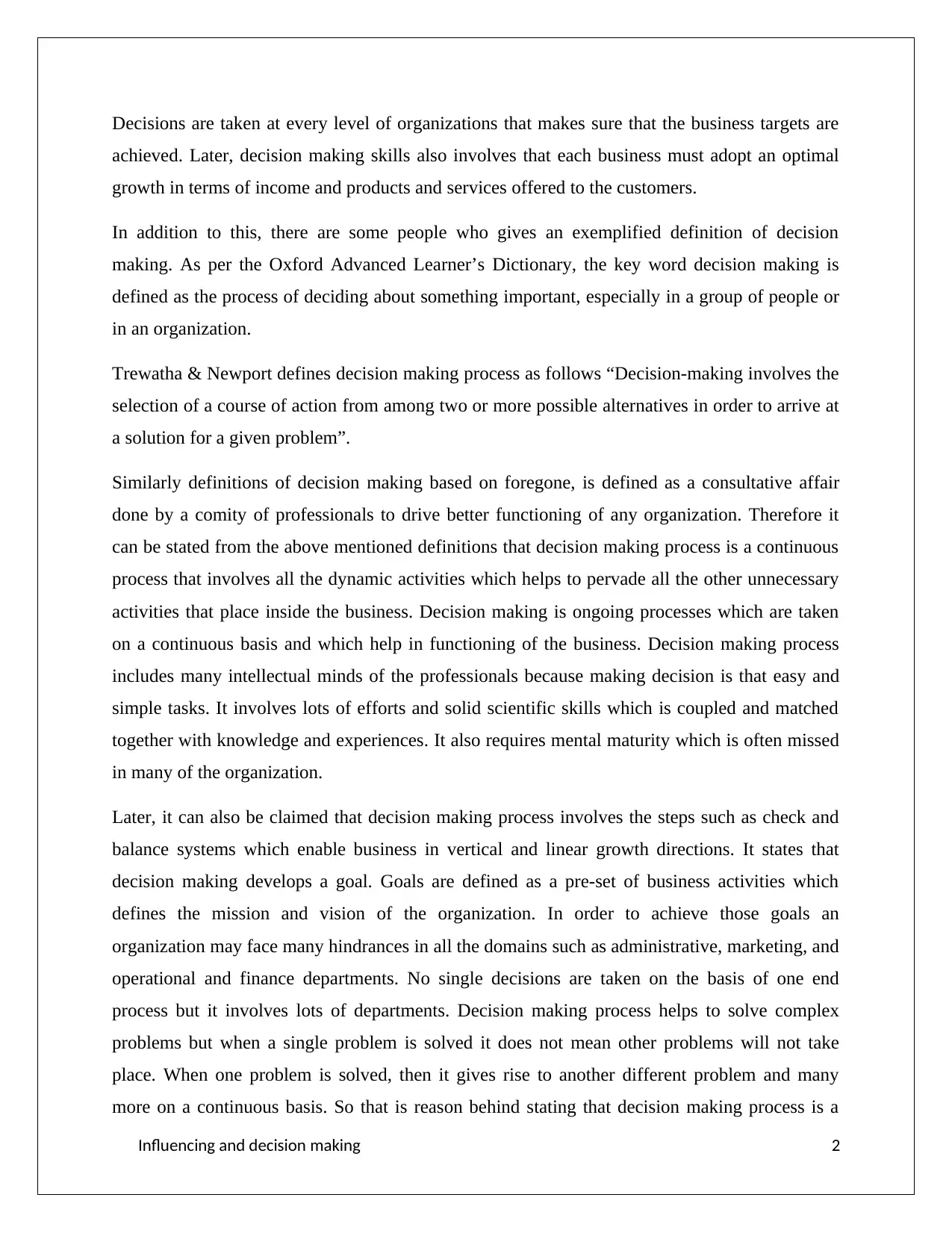
Decisions are taken at every level of organizations that makes sure that the business targets are
achieved. Later, decision making skills also involves that each business must adopt an optimal
growth in terms of income and products and services offered to the customers.
In addition to this, there are some people who gives an exemplified definition of decision
making. As per the Oxford Advanced Learner’s Dictionary, the key word decision making is
defined as the process of deciding about something important, especially in a group of people or
in an organization.
Trewatha & Newport defines decision making process as follows “Decision-making involves the
selection of a course of action from among two or more possible alternatives in order to arrive at
a solution for a given problem”.
Similarly definitions of decision making based on foregone, is defined as a consultative affair
done by a comity of professionals to drive better functioning of any organization. Therefore it
can be stated from the above mentioned definitions that decision making process is a continuous
process that involves all the dynamic activities which helps to pervade all the other unnecessary
activities that place inside the business. Decision making is ongoing processes which are taken
on a continuous basis and which help in functioning of the business. Decision making process
includes many intellectual minds of the professionals because making decision is that easy and
simple tasks. It involves lots of efforts and solid scientific skills which is coupled and matched
together with knowledge and experiences. It also requires mental maturity which is often missed
in many of the organization.
Later, it can also be claimed that decision making process involves the steps such as check and
balance systems which enable business in vertical and linear growth directions. It states that
decision making develops a goal. Goals are defined as a pre-set of business activities which
defines the mission and vision of the organization. In order to achieve those goals an
organization may face many hindrances in all the domains such as administrative, marketing, and
operational and finance departments. No single decisions are taken on the basis of one end
process but it involves lots of departments. Decision making process helps to solve complex
problems but when a single problem is solved it does not mean other problems will not take
place. When one problem is solved, then it gives rise to another different problem and many
more on a continuous basis. So that is reason behind stating that decision making process is a
Influencing and decision making 2
achieved. Later, decision making skills also involves that each business must adopt an optimal
growth in terms of income and products and services offered to the customers.
In addition to this, there are some people who gives an exemplified definition of decision
making. As per the Oxford Advanced Learner’s Dictionary, the key word decision making is
defined as the process of deciding about something important, especially in a group of people or
in an organization.
Trewatha & Newport defines decision making process as follows “Decision-making involves the
selection of a course of action from among two or more possible alternatives in order to arrive at
a solution for a given problem”.
Similarly definitions of decision making based on foregone, is defined as a consultative affair
done by a comity of professionals to drive better functioning of any organization. Therefore it
can be stated from the above mentioned definitions that decision making process is a continuous
process that involves all the dynamic activities which helps to pervade all the other unnecessary
activities that place inside the business. Decision making is ongoing processes which are taken
on a continuous basis and which help in functioning of the business. Decision making process
includes many intellectual minds of the professionals because making decision is that easy and
simple tasks. It involves lots of efforts and solid scientific skills which is coupled and matched
together with knowledge and experiences. It also requires mental maturity which is often missed
in many of the organization.
Later, it can also be claimed that decision making process involves the steps such as check and
balance systems which enable business in vertical and linear growth directions. It states that
decision making develops a goal. Goals are defined as a pre-set of business activities which
defines the mission and vision of the organization. In order to achieve those goals an
organization may face many hindrances in all the domains such as administrative, marketing, and
operational and finance departments. No single decisions are taken on the basis of one end
process but it involves lots of departments. Decision making process helps to solve complex
problems but when a single problem is solved it does not mean other problems will not take
place. When one problem is solved, then it gives rise to another different problem and many
more on a continuous basis. So that is reason behind stating that decision making process is a
Influencing and decision making 2
⊘ This is a preview!⊘
Do you want full access?
Subscribe today to unlock all pages.

Trusted by 1+ million students worldwide
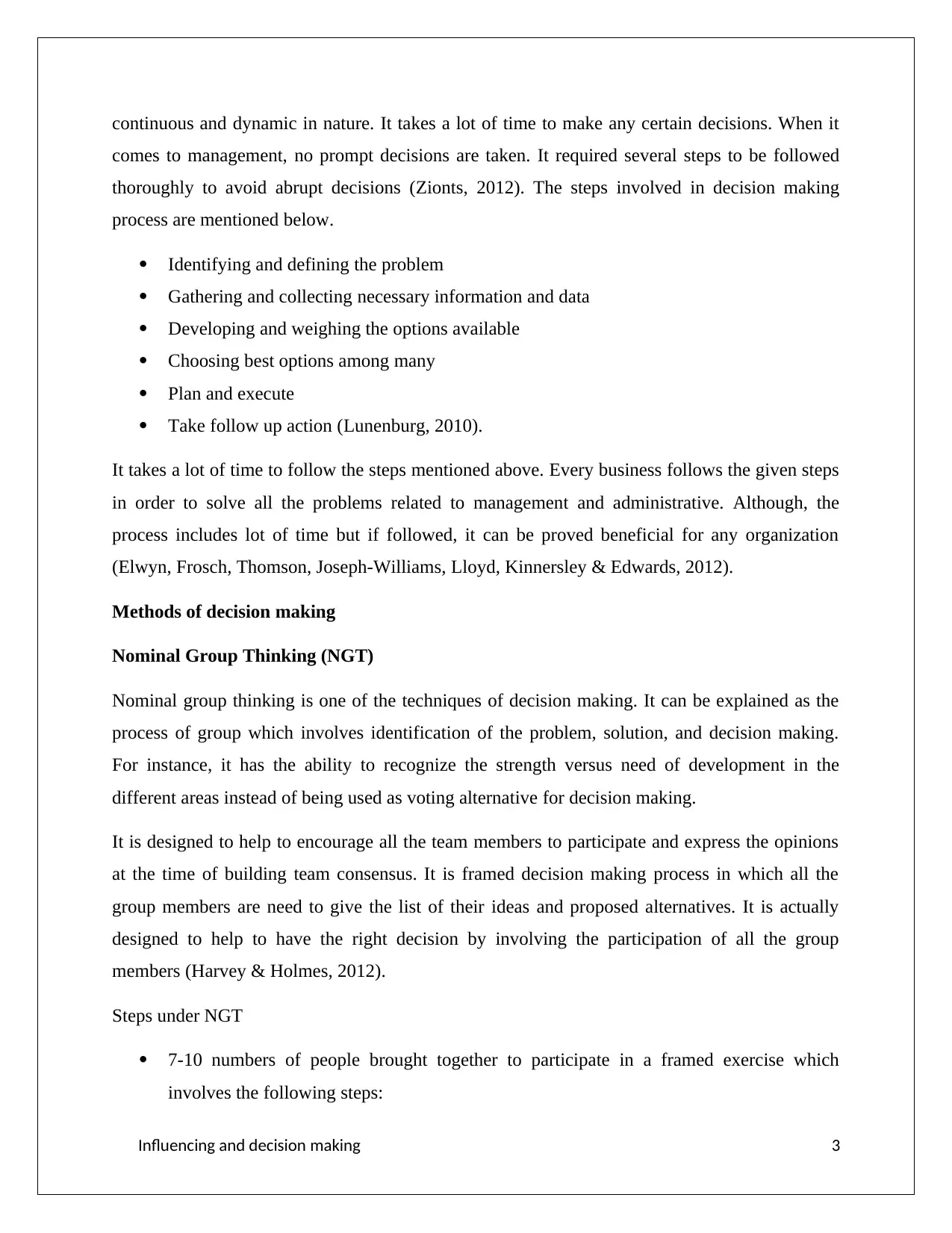
continuous and dynamic in nature. It takes a lot of time to make any certain decisions. When it
comes to management, no prompt decisions are taken. It required several steps to be followed
thoroughly to avoid abrupt decisions (Zionts, 2012). The steps involved in decision making
process are mentioned below.
Identifying and defining the problem
Gathering and collecting necessary information and data
Developing and weighing the options available
Choosing best options among many
Plan and execute
Take follow up action (Lunenburg, 2010).
It takes a lot of time to follow the steps mentioned above. Every business follows the given steps
in order to solve all the problems related to management and administrative. Although, the
process includes lot of time but if followed, it can be proved beneficial for any organization
(Elwyn, Frosch, Thomson, Joseph-Williams, Lloyd, Kinnersley & Edwards, 2012).
Methods of decision making
Nominal Group Thinking (NGT)
Nominal group thinking is one of the techniques of decision making. It can be explained as the
process of group which involves identification of the problem, solution, and decision making.
For instance, it has the ability to recognize the strength versus need of development in the
different areas instead of being used as voting alternative for decision making.
It is designed to help to encourage all the team members to participate and express the opinions
at the time of building team consensus. It is framed decision making process in which all the
group members are need to give the list of their ideas and proposed alternatives. It is actually
designed to help to have the right decision by involving the participation of all the group
members (Harvey & Holmes, 2012).
Steps under NGT
7-10 numbers of people brought together to participate in a framed exercise which
involves the following steps:
Influencing and decision making 3
comes to management, no prompt decisions are taken. It required several steps to be followed
thoroughly to avoid abrupt decisions (Zionts, 2012). The steps involved in decision making
process are mentioned below.
Identifying and defining the problem
Gathering and collecting necessary information and data
Developing and weighing the options available
Choosing best options among many
Plan and execute
Take follow up action (Lunenburg, 2010).
It takes a lot of time to follow the steps mentioned above. Every business follows the given steps
in order to solve all the problems related to management and administrative. Although, the
process includes lot of time but if followed, it can be proved beneficial for any organization
(Elwyn, Frosch, Thomson, Joseph-Williams, Lloyd, Kinnersley & Edwards, 2012).
Methods of decision making
Nominal Group Thinking (NGT)
Nominal group thinking is one of the techniques of decision making. It can be explained as the
process of group which involves identification of the problem, solution, and decision making.
For instance, it has the ability to recognize the strength versus need of development in the
different areas instead of being used as voting alternative for decision making.
It is designed to help to encourage all the team members to participate and express the opinions
at the time of building team consensus. It is framed decision making process in which all the
group members are need to give the list of their ideas and proposed alternatives. It is actually
designed to help to have the right decision by involving the participation of all the group
members (Harvey & Holmes, 2012).
Steps under NGT
7-10 numbers of people brought together to participate in a framed exercise which
involves the following steps:
Influencing and decision making 3
Paraphrase This Document
Need a fresh take? Get an instant paraphrase of this document with our AI Paraphraser
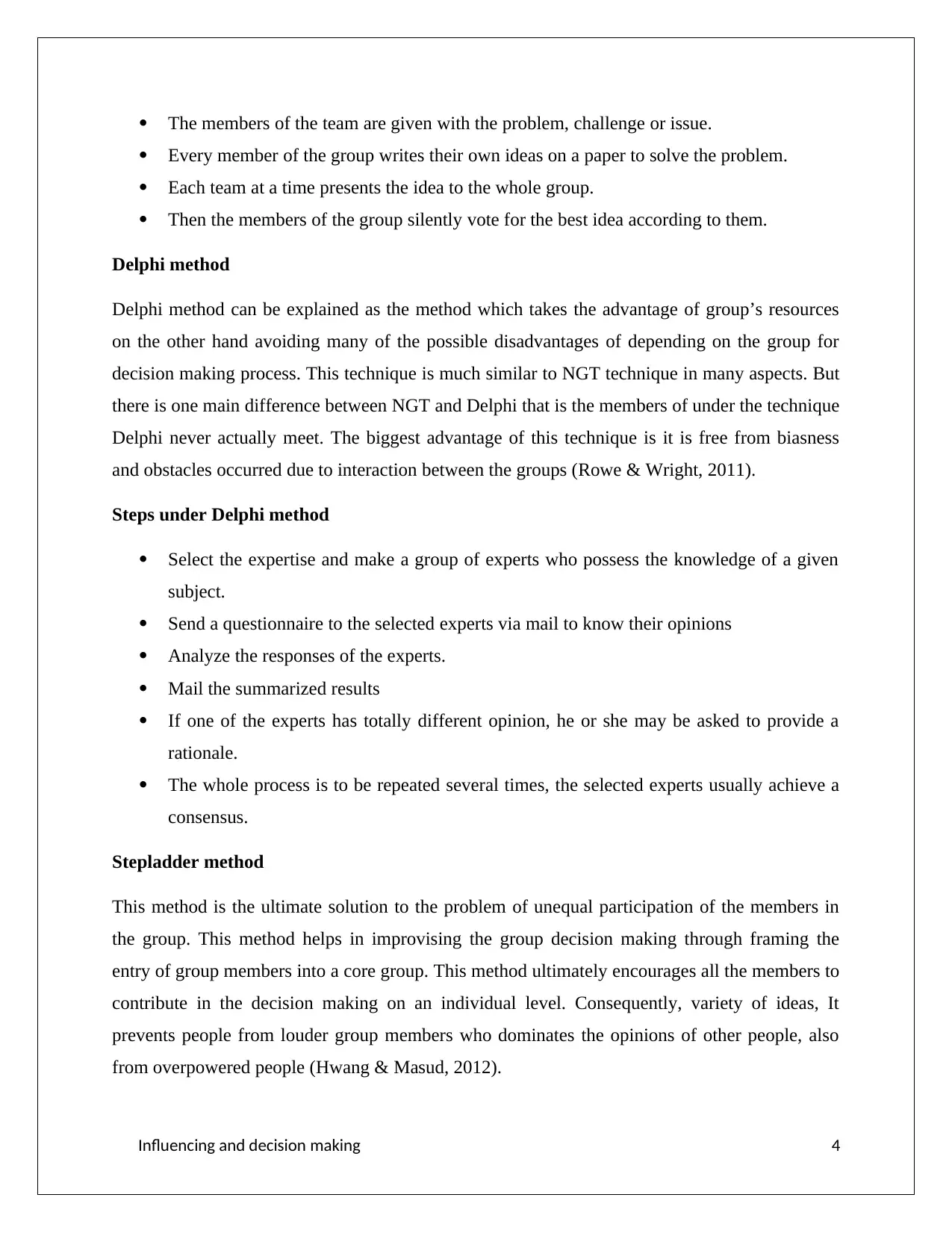
The members of the team are given with the problem, challenge or issue.
Every member of the group writes their own ideas on a paper to solve the problem.
Each team at a time presents the idea to the whole group.
Then the members of the group silently vote for the best idea according to them.
Delphi method
Delphi method can be explained as the method which takes the advantage of group’s resources
on the other hand avoiding many of the possible disadvantages of depending on the group for
decision making process. This technique is much similar to NGT technique in many aspects. But
there is one main difference between NGT and Delphi that is the members of under the technique
Delphi never actually meet. The biggest advantage of this technique is it is free from biasness
and obstacles occurred due to interaction between the groups (Rowe & Wright, 2011).
Steps under Delphi method
Select the expertise and make a group of experts who possess the knowledge of a given
subject.
Send a questionnaire to the selected experts via mail to know their opinions
Analyze the responses of the experts.
Mail the summarized results
If one of the experts has totally different opinion, he or she may be asked to provide a
rationale.
The whole process is to be repeated several times, the selected experts usually achieve a
consensus.
Stepladder method
This method is the ultimate solution to the problem of unequal participation of the members in
the group. This method helps in improvising the group decision making through framing the
entry of group members into a core group. This method ultimately encourages all the members to
contribute in the decision making on an individual level. Consequently, variety of ideas, It
prevents people from louder group members who dominates the opinions of other people, also
from overpowered people (Hwang & Masud, 2012).
Influencing and decision making 4
Every member of the group writes their own ideas on a paper to solve the problem.
Each team at a time presents the idea to the whole group.
Then the members of the group silently vote for the best idea according to them.
Delphi method
Delphi method can be explained as the method which takes the advantage of group’s resources
on the other hand avoiding many of the possible disadvantages of depending on the group for
decision making process. This technique is much similar to NGT technique in many aspects. But
there is one main difference between NGT and Delphi that is the members of under the technique
Delphi never actually meet. The biggest advantage of this technique is it is free from biasness
and obstacles occurred due to interaction between the groups (Rowe & Wright, 2011).
Steps under Delphi method
Select the expertise and make a group of experts who possess the knowledge of a given
subject.
Send a questionnaire to the selected experts via mail to know their opinions
Analyze the responses of the experts.
Mail the summarized results
If one of the experts has totally different opinion, he or she may be asked to provide a
rationale.
The whole process is to be repeated several times, the selected experts usually achieve a
consensus.
Stepladder method
This method is the ultimate solution to the problem of unequal participation of the members in
the group. This method helps in improvising the group decision making through framing the
entry of group members into a core group. This method ultimately encourages all the members to
contribute in the decision making on an individual level. Consequently, variety of ideas, It
prevents people from louder group members who dominates the opinions of other people, also
from overpowered people (Hwang & Masud, 2012).
Influencing and decision making 4
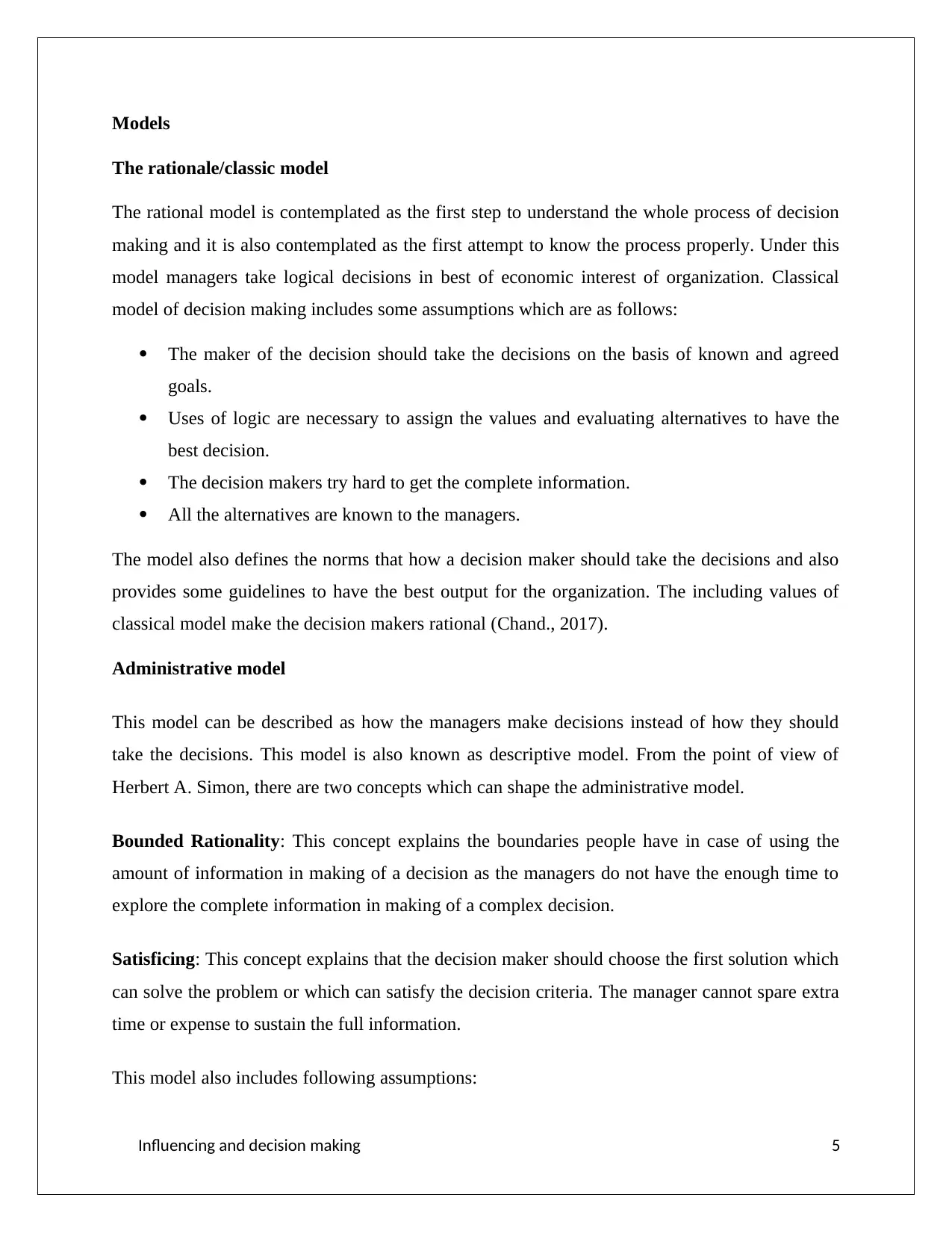
Models
The rationale/classic model
The rational model is contemplated as the first step to understand the whole process of decision
making and it is also contemplated as the first attempt to know the process properly. Under this
model managers take logical decisions in best of economic interest of organization. Classical
model of decision making includes some assumptions which are as follows:
The maker of the decision should take the decisions on the basis of known and agreed
goals.
Uses of logic are necessary to assign the values and evaluating alternatives to have the
best decision.
The decision makers try hard to get the complete information.
All the alternatives are known to the managers.
The model also defines the norms that how a decision maker should take the decisions and also
provides some guidelines to have the best output for the organization. The including values of
classical model make the decision makers rational (Chand., 2017).
Administrative model
This model can be described as how the managers make decisions instead of how they should
take the decisions. This model is also known as descriptive model. From the point of view of
Herbert A. Simon, there are two concepts which can shape the administrative model.
Bounded Rationality: This concept explains the boundaries people have in case of using the
amount of information in making of a decision as the managers do not have the enough time to
explore the complete information in making of a complex decision.
Satisficing: This concept explains that the decision maker should choose the first solution which
can solve the problem or which can satisfy the decision criteria. The manager cannot spare extra
time or expense to sustain the full information.
This model also includes following assumptions:
Influencing and decision making 5
The rationale/classic model
The rational model is contemplated as the first step to understand the whole process of decision
making and it is also contemplated as the first attempt to know the process properly. Under this
model managers take logical decisions in best of economic interest of organization. Classical
model of decision making includes some assumptions which are as follows:
The maker of the decision should take the decisions on the basis of known and agreed
goals.
Uses of logic are necessary to assign the values and evaluating alternatives to have the
best decision.
The decision makers try hard to get the complete information.
All the alternatives are known to the managers.
The model also defines the norms that how a decision maker should take the decisions and also
provides some guidelines to have the best output for the organization. The including values of
classical model make the decision makers rational (Chand., 2017).
Administrative model
This model can be described as how the managers make decisions instead of how they should
take the decisions. This model is also known as descriptive model. From the point of view of
Herbert A. Simon, there are two concepts which can shape the administrative model.
Bounded Rationality: This concept explains the boundaries people have in case of using the
amount of information in making of a decision as the managers do not have the enough time to
explore the complete information in making of a complex decision.
Satisficing: This concept explains that the decision maker should choose the first solution which
can solve the problem or which can satisfy the decision criteria. The manager cannot spare extra
time or expense to sustain the full information.
This model also includes following assumptions:
Influencing and decision making 5
⊘ This is a preview!⊘
Do you want full access?
Subscribe today to unlock all pages.

Trusted by 1+ million students worldwide
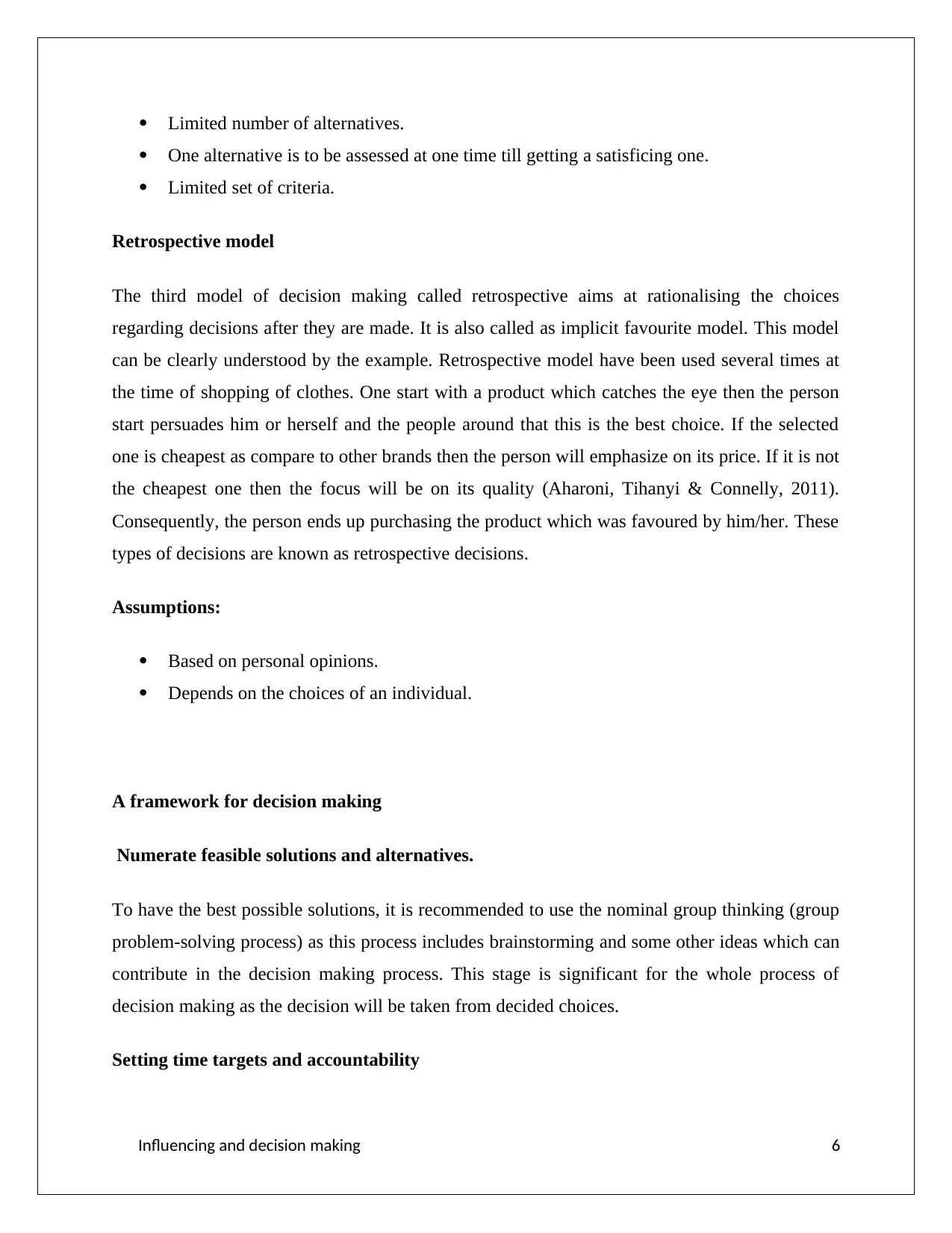
Limited number of alternatives.
One alternative is to be assessed at one time till getting a satisficing one.
Limited set of criteria.
Retrospective model
The third model of decision making called retrospective aims at rationalising the choices
regarding decisions after they are made. It is also called as implicit favourite model. This model
can be clearly understood by the example. Retrospective model have been used several times at
the time of shopping of clothes. One start with a product which catches the eye then the person
start persuades him or herself and the people around that this is the best choice. If the selected
one is cheapest as compare to other brands then the person will emphasize on its price. If it is not
the cheapest one then the focus will be on its quality (Aharoni, Tihanyi & Connelly, 2011).
Consequently, the person ends up purchasing the product which was favoured by him/her. These
types of decisions are known as retrospective decisions.
Assumptions:
Based on personal opinions.
Depends on the choices of an individual.
A framework for decision making
Numerate feasible solutions and alternatives.
To have the best possible solutions, it is recommended to use the nominal group thinking (group
problem-solving process) as this process includes brainstorming and some other ideas which can
contribute in the decision making process. This stage is significant for the whole process of
decision making as the decision will be taken from decided choices.
Setting time targets and accountability
Influencing and decision making 6
One alternative is to be assessed at one time till getting a satisficing one.
Limited set of criteria.
Retrospective model
The third model of decision making called retrospective aims at rationalising the choices
regarding decisions after they are made. It is also called as implicit favourite model. This model
can be clearly understood by the example. Retrospective model have been used several times at
the time of shopping of clothes. One start with a product which catches the eye then the person
start persuades him or herself and the people around that this is the best choice. If the selected
one is cheapest as compare to other brands then the person will emphasize on its price. If it is not
the cheapest one then the focus will be on its quality (Aharoni, Tihanyi & Connelly, 2011).
Consequently, the person ends up purchasing the product which was favoured by him/her. These
types of decisions are known as retrospective decisions.
Assumptions:
Based on personal opinions.
Depends on the choices of an individual.
A framework for decision making
Numerate feasible solutions and alternatives.
To have the best possible solutions, it is recommended to use the nominal group thinking (group
problem-solving process) as this process includes brainstorming and some other ideas which can
contribute in the decision making process. This stage is significant for the whole process of
decision making as the decision will be taken from decided choices.
Setting time targets and accountability
Influencing and decision making 6
Paraphrase This Document
Need a fresh take? Get an instant paraphrase of this document with our AI Paraphraser
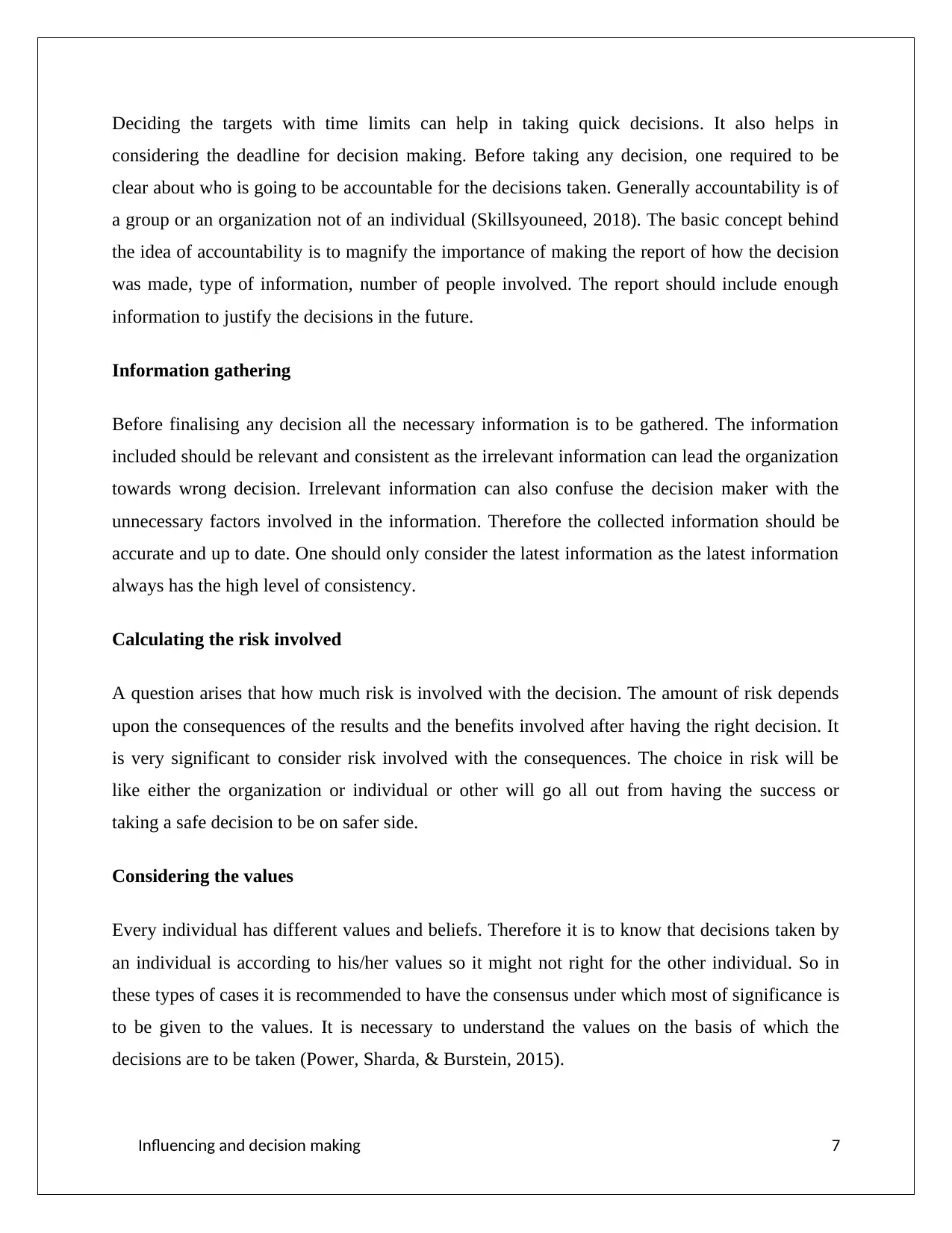
Deciding the targets with time limits can help in taking quick decisions. It also helps in
considering the deadline for decision making. Before taking any decision, one required to be
clear about who is going to be accountable for the decisions taken. Generally accountability is of
a group or an organization not of an individual (Skillsyouneed, 2018). The basic concept behind
the idea of accountability is to magnify the importance of making the report of how the decision
was made, type of information, number of people involved. The report should include enough
information to justify the decisions in the future.
Information gathering
Before finalising any decision all the necessary information is to be gathered. The information
included should be relevant and consistent as the irrelevant information can lead the organization
towards wrong decision. Irrelevant information can also confuse the decision maker with the
unnecessary factors involved in the information. Therefore the collected information should be
accurate and up to date. One should only consider the latest information as the latest information
always has the high level of consistency.
Calculating the risk involved
A question arises that how much risk is involved with the decision. The amount of risk depends
upon the consequences of the results and the benefits involved after having the right decision. It
is very significant to consider risk involved with the consequences. The choice in risk will be
like either the organization or individual or other will go all out from having the success or
taking a safe decision to be on safer side.
Considering the values
Every individual has different values and beliefs. Therefore it is to know that decisions taken by
an individual is according to his/her values so it might not right for the other individual. So in
these types of cases it is recommended to have the consensus under which most of significance is
to be given to the values. It is necessary to understand the values on the basis of which the
decisions are to be taken (Power, Sharda, & Burstein, 2015).
Influencing and decision making 7
considering the deadline for decision making. Before taking any decision, one required to be
clear about who is going to be accountable for the decisions taken. Generally accountability is of
a group or an organization not of an individual (Skillsyouneed, 2018). The basic concept behind
the idea of accountability is to magnify the importance of making the report of how the decision
was made, type of information, number of people involved. The report should include enough
information to justify the decisions in the future.
Information gathering
Before finalising any decision all the necessary information is to be gathered. The information
included should be relevant and consistent as the irrelevant information can lead the organization
towards wrong decision. Irrelevant information can also confuse the decision maker with the
unnecessary factors involved in the information. Therefore the collected information should be
accurate and up to date. One should only consider the latest information as the latest information
always has the high level of consistency.
Calculating the risk involved
A question arises that how much risk is involved with the decision. The amount of risk depends
upon the consequences of the results and the benefits involved after having the right decision. It
is very significant to consider risk involved with the consequences. The choice in risk will be
like either the organization or individual or other will go all out from having the success or
taking a safe decision to be on safer side.
Considering the values
Every individual has different values and beliefs. Therefore it is to know that decisions taken by
an individual is according to his/her values so it might not right for the other individual. So in
these types of cases it is recommended to have the consensus under which most of significance is
to be given to the values. It is necessary to understand the values on the basis of which the
decisions are to be taken (Power, Sharda, & Burstein, 2015).
Influencing and decision making 7
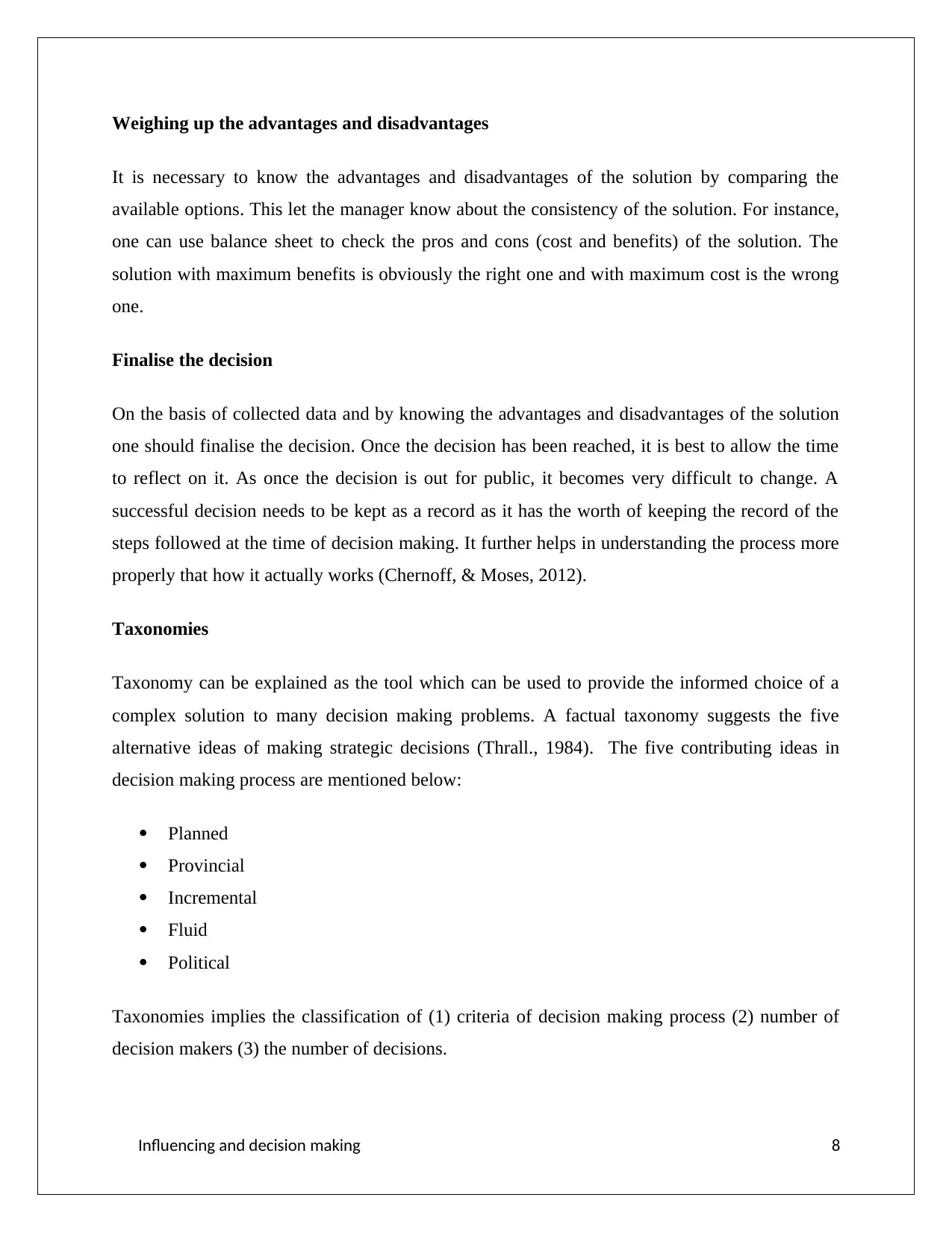
Weighing up the advantages and disadvantages
It is necessary to know the advantages and disadvantages of the solution by comparing the
available options. This let the manager know about the consistency of the solution. For instance,
one can use balance sheet to check the pros and cons (cost and benefits) of the solution. The
solution with maximum benefits is obviously the right one and with maximum cost is the wrong
one.
Finalise the decision
On the basis of collected data and by knowing the advantages and disadvantages of the solution
one should finalise the decision. Once the decision has been reached, it is best to allow the time
to reflect on it. As once the decision is out for public, it becomes very difficult to change. A
successful decision needs to be kept as a record as it has the worth of keeping the record of the
steps followed at the time of decision making. It further helps in understanding the process more
properly that how it actually works (Chernoff, & Moses, 2012).
Taxonomies
Taxonomy can be explained as the tool which can be used to provide the informed choice of a
complex solution to many decision making problems. A factual taxonomy suggests the five
alternative ideas of making strategic decisions (Thrall., 1984). The five contributing ideas in
decision making process are mentioned below:
Planned
Provincial
Incremental
Fluid
Political
Taxonomies implies the classification of (1) criteria of decision making process (2) number of
decision makers (3) the number of decisions.
Influencing and decision making 8
It is necessary to know the advantages and disadvantages of the solution by comparing the
available options. This let the manager know about the consistency of the solution. For instance,
one can use balance sheet to check the pros and cons (cost and benefits) of the solution. The
solution with maximum benefits is obviously the right one and with maximum cost is the wrong
one.
Finalise the decision
On the basis of collected data and by knowing the advantages and disadvantages of the solution
one should finalise the decision. Once the decision has been reached, it is best to allow the time
to reflect on it. As once the decision is out for public, it becomes very difficult to change. A
successful decision needs to be kept as a record as it has the worth of keeping the record of the
steps followed at the time of decision making. It further helps in understanding the process more
properly that how it actually works (Chernoff, & Moses, 2012).
Taxonomies
Taxonomy can be explained as the tool which can be used to provide the informed choice of a
complex solution to many decision making problems. A factual taxonomy suggests the five
alternative ideas of making strategic decisions (Thrall., 1984). The five contributing ideas in
decision making process are mentioned below:
Planned
Provincial
Incremental
Fluid
Political
Taxonomies implies the classification of (1) criteria of decision making process (2) number of
decision makers (3) the number of decisions.
Influencing and decision making 8
⊘ This is a preview!⊘
Do you want full access?
Subscribe today to unlock all pages.

Trusted by 1+ million students worldwide
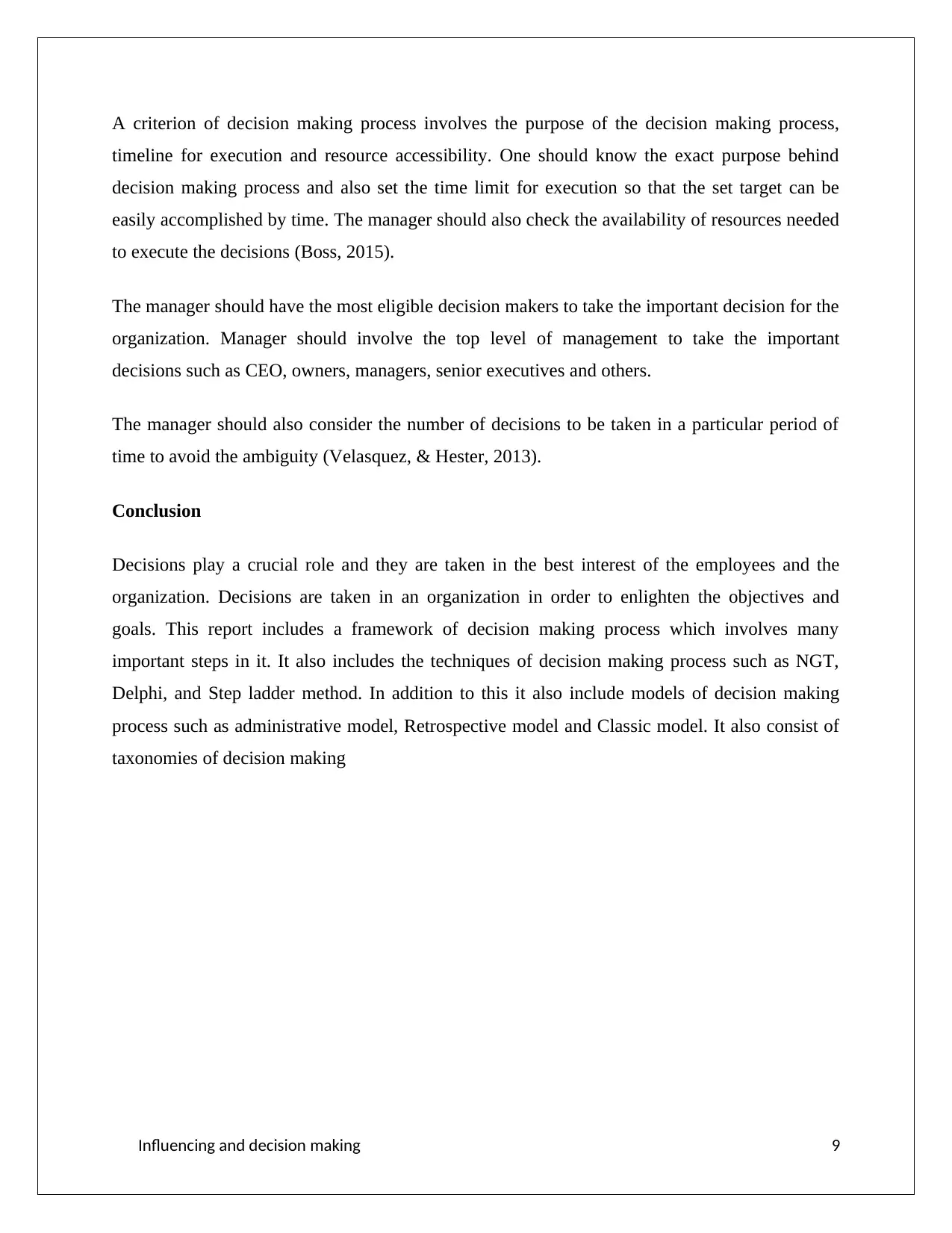
A criterion of decision making process involves the purpose of the decision making process,
timeline for execution and resource accessibility. One should know the exact purpose behind
decision making process and also set the time limit for execution so that the set target can be
easily accomplished by time. The manager should also check the availability of resources needed
to execute the decisions (Boss, 2015).
The manager should have the most eligible decision makers to take the important decision for the
organization. Manager should involve the top level of management to take the important
decisions such as CEO, owners, managers, senior executives and others.
The manager should also consider the number of decisions to be taken in a particular period of
time to avoid the ambiguity (Velasquez, & Hester, 2013).
Conclusion
Decisions play a crucial role and they are taken in the best interest of the employees and the
organization. Decisions are taken in an organization in order to enlighten the objectives and
goals. This report includes a framework of decision making process which involves many
important steps in it. It also includes the techniques of decision making process such as NGT,
Delphi, and Step ladder method. In addition to this it also include models of decision making
process such as administrative model, Retrospective model and Classic model. It also consist of
taxonomies of decision making
Influencing and decision making 9
timeline for execution and resource accessibility. One should know the exact purpose behind
decision making process and also set the time limit for execution so that the set target can be
easily accomplished by time. The manager should also check the availability of resources needed
to execute the decisions (Boss, 2015).
The manager should have the most eligible decision makers to take the important decision for the
organization. Manager should involve the top level of management to take the important
decisions such as CEO, owners, managers, senior executives and others.
The manager should also consider the number of decisions to be taken in a particular period of
time to avoid the ambiguity (Velasquez, & Hester, 2013).
Conclusion
Decisions play a crucial role and they are taken in the best interest of the employees and the
organization. Decisions are taken in an organization in order to enlighten the objectives and
goals. This report includes a framework of decision making process which involves many
important steps in it. It also includes the techniques of decision making process such as NGT,
Delphi, and Step ladder method. In addition to this it also include models of decision making
process such as administrative model, Retrospective model and Classic model. It also consist of
taxonomies of decision making
Influencing and decision making 9
Paraphrase This Document
Need a fresh take? Get an instant paraphrase of this document with our AI Paraphraser
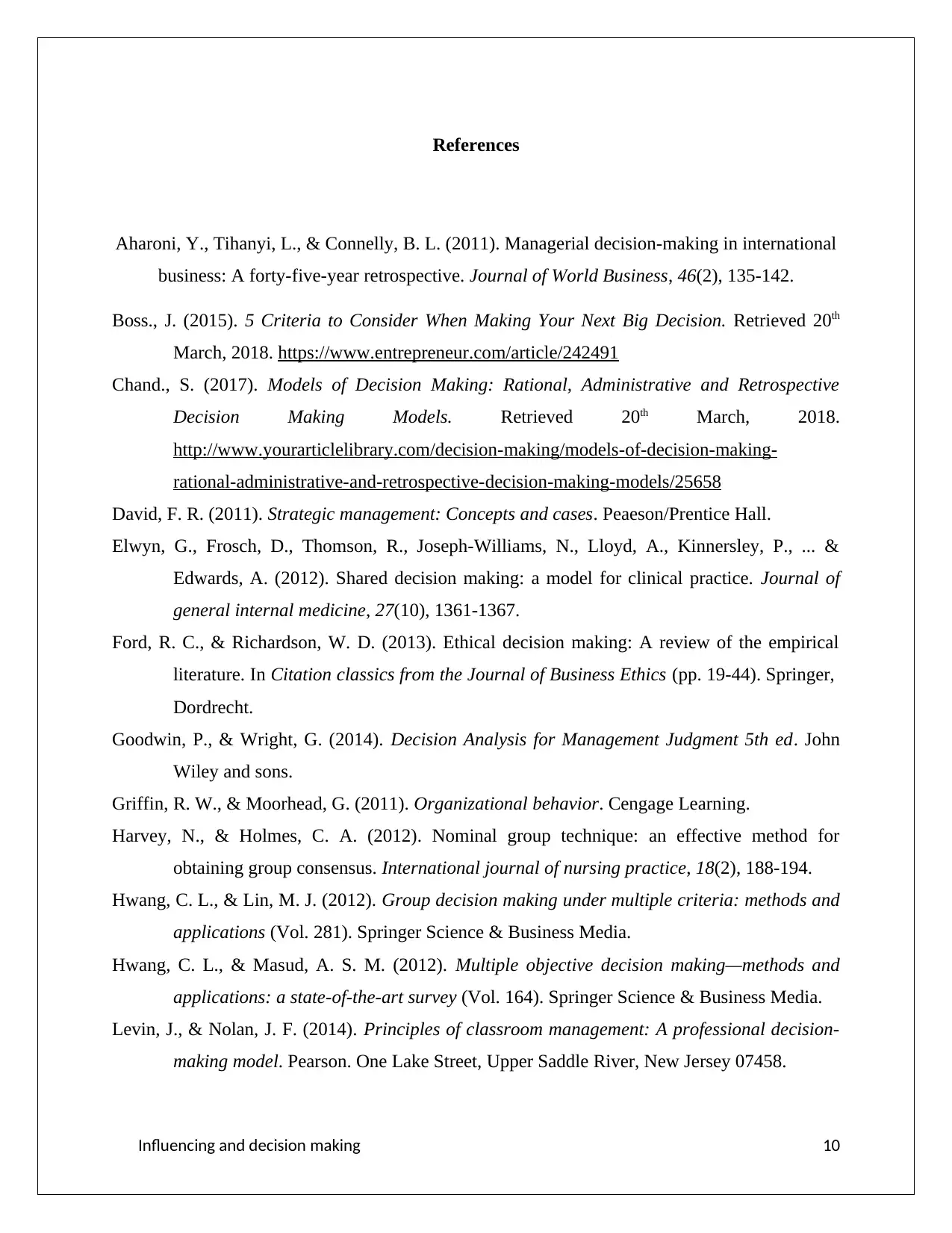
References
Aharoni, Y., Tihanyi, L., & Connelly, B. L. (2011). Managerial decision-making in international
business: A forty-five-year retrospective. Journal of World Business, 46(2), 135-142.
Boss., J. (2015). 5 Criteria to Consider When Making Your Next Big Decision. Retrieved 20th
March, 2018. https://www.entrepreneur.com/article/242491
Chand., S. (2017). Models of Decision Making: Rational, Administrative and Retrospective
Decision Making Models. Retrieved 20th March, 2018.
http://www.yourarticlelibrary.com/decision-making/models-of-decision-making-
rational-administrative-and-retrospective-decision-making-models/25658
David, F. R. (2011). Strategic management: Concepts and cases. Peaeson/Prentice Hall.
Elwyn, G., Frosch, D., Thomson, R., Joseph-Williams, N., Lloyd, A., Kinnersley, P., ... &
Edwards, A. (2012). Shared decision making: a model for clinical practice. Journal of
general internal medicine, 27(10), 1361-1367.
Ford, R. C., & Richardson, W. D. (2013). Ethical decision making: A review of the empirical
literature. In Citation classics from the Journal of Business Ethics (pp. 19-44). Springer,
Dordrecht.
Goodwin, P., & Wright, G. (2014). Decision Analysis for Management Judgment 5th ed. John
Wiley and sons.
Griffin, R. W., & Moorhead, G. (2011). Organizational behavior. Cengage Learning.
Harvey, N., & Holmes, C. A. (2012). Nominal group technique: an effective method for
obtaining group consensus. International journal of nursing practice, 18(2), 188-194.
Hwang, C. L., & Lin, M. J. (2012). Group decision making under multiple criteria: methods and
applications (Vol. 281). Springer Science & Business Media.
Hwang, C. L., & Masud, A. S. M. (2012). Multiple objective decision making—methods and
applications: a state-of-the-art survey (Vol. 164). Springer Science & Business Media.
Levin, J., & Nolan, J. F. (2014). Principles of classroom management: A professional decision-
making model. Pearson. One Lake Street, Upper Saddle River, New Jersey 07458.
Influencing and decision making 10
Aharoni, Y., Tihanyi, L., & Connelly, B. L. (2011). Managerial decision-making in international
business: A forty-five-year retrospective. Journal of World Business, 46(2), 135-142.
Boss., J. (2015). 5 Criteria to Consider When Making Your Next Big Decision. Retrieved 20th
March, 2018. https://www.entrepreneur.com/article/242491
Chand., S. (2017). Models of Decision Making: Rational, Administrative and Retrospective
Decision Making Models. Retrieved 20th March, 2018.
http://www.yourarticlelibrary.com/decision-making/models-of-decision-making-
rational-administrative-and-retrospective-decision-making-models/25658
David, F. R. (2011). Strategic management: Concepts and cases. Peaeson/Prentice Hall.
Elwyn, G., Frosch, D., Thomson, R., Joseph-Williams, N., Lloyd, A., Kinnersley, P., ... &
Edwards, A. (2012). Shared decision making: a model for clinical practice. Journal of
general internal medicine, 27(10), 1361-1367.
Ford, R. C., & Richardson, W. D. (2013). Ethical decision making: A review of the empirical
literature. In Citation classics from the Journal of Business Ethics (pp. 19-44). Springer,
Dordrecht.
Goodwin, P., & Wright, G. (2014). Decision Analysis for Management Judgment 5th ed. John
Wiley and sons.
Griffin, R. W., & Moorhead, G. (2011). Organizational behavior. Cengage Learning.
Harvey, N., & Holmes, C. A. (2012). Nominal group technique: an effective method for
obtaining group consensus. International journal of nursing practice, 18(2), 188-194.
Hwang, C. L., & Lin, M. J. (2012). Group decision making under multiple criteria: methods and
applications (Vol. 281). Springer Science & Business Media.
Hwang, C. L., & Masud, A. S. M. (2012). Multiple objective decision making—methods and
applications: a state-of-the-art survey (Vol. 164). Springer Science & Business Media.
Levin, J., & Nolan, J. F. (2014). Principles of classroom management: A professional decision-
making model. Pearson. One Lake Street, Upper Saddle River, New Jersey 07458.
Influencing and decision making 10
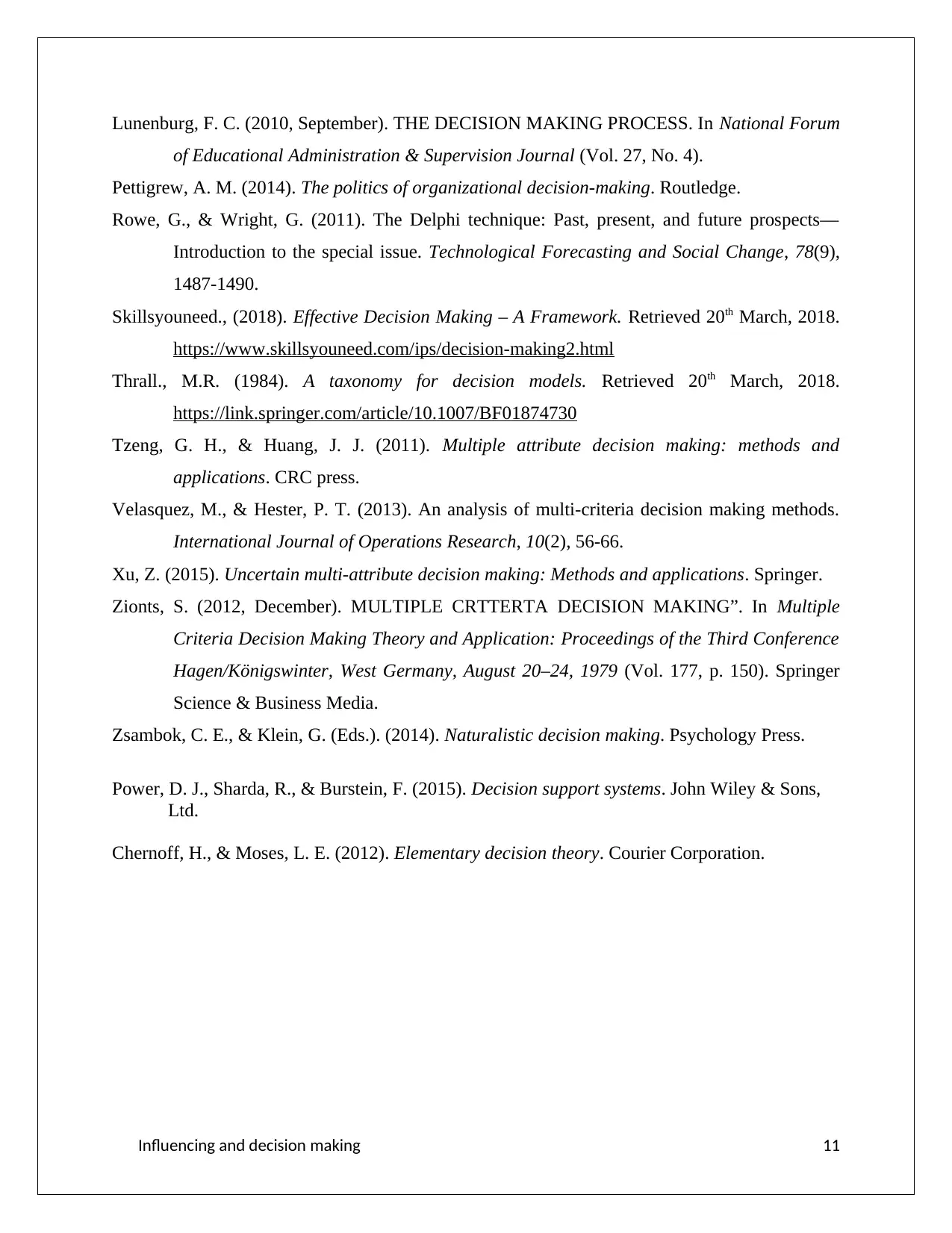
Lunenburg, F. C. (2010, September). THE DECISION MAKING PROCESS. In National Forum
of Educational Administration & Supervision Journal (Vol. 27, No. 4).
Pettigrew, A. M. (2014). The politics of organizational decision-making. Routledge.
Rowe, G., & Wright, G. (2011). The Delphi technique: Past, present, and future prospects—
Introduction to the special issue. Technological Forecasting and Social Change, 78(9),
1487-1490.
Skillsyouneed., (2018). Effective Decision Making – A Framework. Retrieved 20th March, 2018.
https://www.skillsyouneed.com/ips/decision-making2.html
Thrall., M.R. (1984). A taxonomy for decision models. Retrieved 20th March, 2018.
https://link.springer.com/article/10.1007/BF01874730
Tzeng, G. H., & Huang, J. J. (2011). Multiple attribute decision making: methods and
applications. CRC press.
Velasquez, M., & Hester, P. T. (2013). An analysis of multi-criteria decision making methods.
International Journal of Operations Research, 10(2), 56-66.
Xu, Z. (2015). Uncertain multi-attribute decision making: Methods and applications. Springer.
Zionts, S. (2012, December). MULTIPLE CRTTERTA DECISION MAKING”. In Multiple
Criteria Decision Making Theory and Application: Proceedings of the Third Conference
Hagen/Königswinter, West Germany, August 20–24, 1979 (Vol. 177, p. 150). Springer
Science & Business Media.
Zsambok, C. E., & Klein, G. (Eds.). (2014). Naturalistic decision making. Psychology Press.
Power, D. J., Sharda, R., & Burstein, F. (2015). Decision support systems. John Wiley & Sons,
Ltd.
Chernoff, H., & Moses, L. E. (2012). Elementary decision theory. Courier Corporation.
Influencing and decision making 11
of Educational Administration & Supervision Journal (Vol. 27, No. 4).
Pettigrew, A. M. (2014). The politics of organizational decision-making. Routledge.
Rowe, G., & Wright, G. (2011). The Delphi technique: Past, present, and future prospects—
Introduction to the special issue. Technological Forecasting and Social Change, 78(9),
1487-1490.
Skillsyouneed., (2018). Effective Decision Making – A Framework. Retrieved 20th March, 2018.
https://www.skillsyouneed.com/ips/decision-making2.html
Thrall., M.R. (1984). A taxonomy for decision models. Retrieved 20th March, 2018.
https://link.springer.com/article/10.1007/BF01874730
Tzeng, G. H., & Huang, J. J. (2011). Multiple attribute decision making: methods and
applications. CRC press.
Velasquez, M., & Hester, P. T. (2013). An analysis of multi-criteria decision making methods.
International Journal of Operations Research, 10(2), 56-66.
Xu, Z. (2015). Uncertain multi-attribute decision making: Methods and applications. Springer.
Zionts, S. (2012, December). MULTIPLE CRTTERTA DECISION MAKING”. In Multiple
Criteria Decision Making Theory and Application: Proceedings of the Third Conference
Hagen/Königswinter, West Germany, August 20–24, 1979 (Vol. 177, p. 150). Springer
Science & Business Media.
Zsambok, C. E., & Klein, G. (Eds.). (2014). Naturalistic decision making. Psychology Press.
Power, D. J., Sharda, R., & Burstein, F. (2015). Decision support systems. John Wiley & Sons,
Ltd.
Chernoff, H., & Moses, L. E. (2012). Elementary decision theory. Courier Corporation.
Influencing and decision making 11
⊘ This is a preview!⊘
Do you want full access?
Subscribe today to unlock all pages.

Trusted by 1+ million students worldwide
1 out of 13
Related Documents
Your All-in-One AI-Powered Toolkit for Academic Success.
+13062052269
info@desklib.com
Available 24*7 on WhatsApp / Email
![[object Object]](/_next/static/media/star-bottom.7253800d.svg)
Unlock your academic potential
Copyright © 2020–2025 A2Z Services. All Rights Reserved. Developed and managed by ZUCOL.




